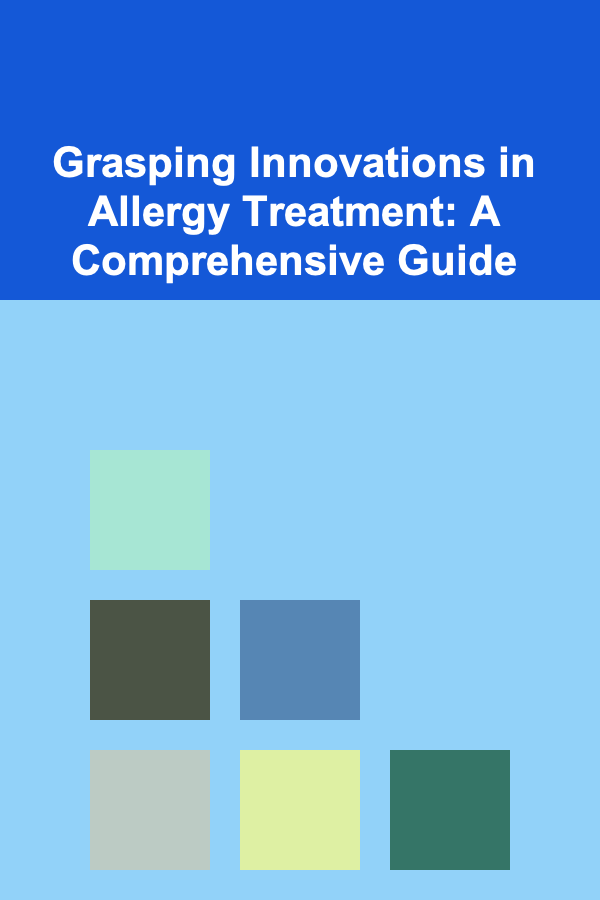
Grasping Innovations in Allergy Treatment: A Comprehensive Guide
ebook include PDF & Audio bundle (Micro Guide)
$12.99$7.99
Limited Time Offer! Order within the next:

Allergies are a pervasive global health issue, affecting millions worldwide. From seasonal hay fever to life-threatening anaphylaxis, allergic reactions can significantly impact quality of life. Understanding the underlying mechanisms of allergies and staying abreast of the latest innovations in treatment is crucial for healthcare professionals, patients, and their families. This article delves into the advancements reshaping the landscape of allergy management, exploring both established approaches and cutting-edge developments that offer hope for more effective and personalized care.
Understanding the Allergic Response: A Foundation for Innovation
Before exploring the innovations, it's essential to understand the basic science of allergy. An allergic reaction is essentially an overreaction of the immune system to a normally harmless substance, called an allergen. This process involves several key players:
- Allergens: These can be diverse, including pollen, dust mites, pet dander, food proteins (e.g., peanuts, milk, eggs), insect venom, and medications.
- IgE Antibodies: When the body encounters an allergen, some individuals produce immunoglobulin E (IgE) antibodies specific to that allergen.
- Mast Cells and Basophils: These immune cells have receptors that bind to IgE antibodies. When an allergen binds to the IgE attached to these cells, it triggers degranulation -- the release of inflammatory mediators like histamine, leukotrienes, and prostaglandins.
- Inflammatory Mediators: These chemicals cause the characteristic symptoms of allergies, such as itching, sneezing, runny nose, skin rashes, hives, and in severe cases, difficulty breathing.
The complexity of the allergic cascade provides numerous targets for therapeutic intervention. Traditional allergy treatments have focused on managing symptoms and avoiding allergens, but recent innovations are targeting the underlying immune mechanisms to provide more durable relief and potentially even cure allergies.
Traditional Allergy Treatments: A Review
While innovation is crucial, understanding the established methods is important. Traditional allergy treatments form the cornerstone of allergy management. These include:
- Allergen Avoidance: This is often the first line of defense. Minimizing exposure to known allergens can significantly reduce the frequency and severity of allergic reactions. This can involve measures such as using air purifiers, frequent cleaning, specialized bedding, and strict dietary restrictions. While effective, allergen avoidance can be challenging and may significantly impact lifestyle.
- Antihistamines: These medications block the action of histamine, a key inflammatory mediator released during allergic reactions. Antihistamines can relieve symptoms such as itching, sneezing, and runny nose. Newer, non-sedating antihistamines are preferred due to their reduced side effects compared to older generations.
- Decongestants: These medications constrict blood vessels in the nasal passages, relieving nasal congestion. They are available as nasal sprays or oral medications. Prolonged use of decongestant nasal sprays can lead to rebound congestion (rhinitis medicamentosa).
- Corticosteroids: These medications reduce inflammation and are available in various forms, including nasal sprays, inhalers, creams, and oral medications. Nasal corticosteroids are often used to treat allergic rhinitis. Oral corticosteroids are typically reserved for more severe allergic reactions due to their potential for systemic side effects.
- Epinephrine Autoinjectors: These devices deliver a life-saving dose of epinephrine (adrenaline) in the event of anaphylaxis, a severe and potentially fatal allergic reaction. Epinephrine helps to reverse the symptoms of anaphylaxis by constricting blood vessels, opening airways, and stimulating the heart. Patients at risk of anaphylaxis should carry an epinephrine autoinjector and be trained on its proper use.
These traditional treatments provide symptomatic relief, but they do not address the underlying cause of allergies. This is where newer innovations offer more promising solutions.
Allergen Immunotherapy: A Deeper Dive and Emerging Approaches
Allergen immunotherapy (AIT) is a treatment that aims to desensitize the immune system to specific allergens. It involves administering gradually increasing doses of the allergen over time, with the goal of reducing or eliminating allergic reactions. AIT is considered the only disease-modifying treatment for allergies.
Subcutaneous Immunotherapy (SCIT)
SCIT, commonly known as allergy shots, has been used for over a century. It involves regular injections of allergen extracts under the skin. SCIT is effective for treating allergic rhinitis, allergic asthma, and stinging insect allergies. The treatment typically takes several years to complete, and patients require regular visits to the allergist's office for injections.
While effective, SCIT has limitations:
- Time Commitment: Requires frequent clinic visits for injections.
- Risk of Systemic Reactions: Although rare, systemic allergic reactions, including anaphylaxis, can occur with SCIT.
- Compliance: The long duration of treatment can lead to poor compliance.
Sublingual Immunotherapy (SLIT)
SLIT involves placing allergen extracts under the tongue. It is available as tablets or liquid drops. SLIT offers several advantages over SCIT:
- Convenience: Can be administered at home, reducing the need for clinic visits.
- Safety: Generally considered safer than SCIT, with a lower risk of systemic reactions.
- Improved Compliance: The ease of administration can improve patient compliance.
SLIT tablets are currently approved for grass pollen, ragweed pollen, and dust mite allergies. SLIT drops are used off-label for a wider range of allergens. While SLIT is generally well-tolerated, some patients may experience mild local reactions, such as itching or tingling in the mouth.
Epicutaneous Immunotherapy (EPIT)
EPIT involves applying allergen extracts to the skin using a patch. The Viaskin Peanut patch, for example, is approved by the FDA for treating peanut allergy in children ages 4-11. EPIT delivers the allergen directly to the skin, where it is taken up by Langerhans cells, which then present the allergen to the immune system. EPIT is designed to desensitize the patient to the allergen without causing systemic reactions. However, EPIT's efficacy compared to other immunotherapy methods is still under investigation and may be less potent in some cases.
Oral Mucosal Immunotherapy (OMIT)
OMIT is an emerging approach that involves delivering allergen extracts to the oral mucosa in a lozenge or other formulation. The goal is to induce immune tolerance through exposure to the allergen in the oral cavity. OMIT is still in early stages of development, but it holds promise as a convenient and safe alternative to other forms of immunotherapy. It aims to stimulate different immune cells and pathways compared to SLIT, potentially offering advantages in specific allergy types or patient populations.
Modified Allergens
Researchers are developing modified allergens that are safer and more effective than traditional allergen extracts. These modifications can include:
- Hypoallergenic Allergens: Altering the allergen molecule to reduce its allergenic potential while retaining its ability to stimulate the immune system.
- Allergoids: Chemically modified allergens that are less allergenic but still capable of inducing immune tolerance.
- Recombinant Allergens: Allergens produced using recombinant DNA technology, allowing for precise control over allergen composition and purity. These can also be engineered to lack specific IgE binding epitopes, reducing the risk of allergic reactions during immunotherapy.
- Peptide Immunotherapy: Using short peptides derived from allergens to stimulate T cell tolerance without triggering IgE-mediated reactions.
These modified allergens aim to improve the safety and efficacy of immunotherapy, making it a more attractive option for a wider range of patients.
Biologic Therapies: Targeting Specific Immune Pathways
Biologic therapies are a class of medications that target specific molecules or cells involved in the allergic response. These therapies offer a more precise and targeted approach to allergy treatment compared to traditional medications.
Anti-IgE Therapy (Omalizumab)
Omalizumab is a monoclonal antibody that binds to IgE, preventing it from binding to mast cells and basophils. This reduces the release of inflammatory mediators during allergic reactions. Omalizumab is approved for treating allergic asthma and chronic idiopathic urticaria (CIU). Recently, it has also been approved for use in food allergy, specifically to reduce the severity of reactions following accidental ingestion of a known allergen. Omalizumab is administered by subcutaneous injection every 2-4 weeks.
Key benefits of omalizumab include:
- Reduced Asthma Exacerbations: Decreases the frequency and severity of asthma attacks in patients with allergic asthma.
- Improved Asthma Control: Improves overall asthma control and reduces the need for other asthma medications.
- Reduced Urticaria Symptoms: Relieves itching and hives in patients with CIU.
- Mitigation of Accidental Food Allergy Reactions: Reduces the severity of reactions from accidental food ingestion.
However, omalizumab also has limitations:
- Cost: It is an expensive medication.
- Administration: Requires regular injections.
- Side Effects: While generally well-tolerated, side effects can include injection site reactions and, rarely, anaphylaxis.
- Not a Cure: It does not cure allergies, but rather manages symptoms.
Anti-IL-5 Therapy (Mepolizumab, Reslizumab, Benralizumab)
Interleukin-5 (IL-5) is a cytokine that plays a key role in the development and survival of eosinophils, a type of white blood cell that contributes to allergic inflammation, particularly in asthma. Anti-IL-5 therapies are monoclonal antibodies that target IL-5 or its receptor, reducing eosinophil levels and inflammation in the airways.
- Mepolizumab: Binds to IL-5, preventing it from binding to its receptor.
- Reslizumab: Also binds to IL-5.
- Benralizumab: Binds to the IL-5 receptor on eosinophils, leading to their depletion.
These medications are approved for treating severe eosinophilic asthma. They are administered by subcutaneous injection or intravenous infusion.
Anti-IL-4 and Anti-IL-13 Therapy (Dupilumab)
Interleukin-4 (IL-4) and interleukin-13 (IL-13) are cytokines that play a central role in the allergic inflammatory cascade, particularly in atopic dermatitis (eczema). Dupilumab is a monoclonal antibody that blocks the signaling of both IL-4 and IL-13.
Dupilumab is approved for treating:
- Atopic Dermatitis: Reduces itching, inflammation, and skin lesions in patients with moderate-to-severe atopic dermatitis.
- Asthma: Approved for certain types of asthma, especially those with high levels of type 2 inflammation.
- Chronic Rhinosinusitis with Nasal Polyps: Reduces the size and number of nasal polyps and improves nasal congestion and smell.
Dupilumab is administered by subcutaneous injection.
TSLP Inhibitors (Tezepelumab)
Thymic stromal lymphopoietin (TSLP) is an epithelial cytokine that initiates the allergic inflammatory cascade. TSLP is released by epithelial cells in response to allergens, viruses, and other irritants. Tezepelumab is a monoclonal antibody that blocks TSLP, preventing it from activating downstream inflammatory pathways.
Tezepelumab is approved for treating severe asthma. It is administered by subcutaneous injection.
These biologic therapies represent a significant advancement in allergy treatment, offering targeted and effective options for patients with severe allergic diseases. However, they are typically reserved for patients who have not responded adequately to traditional therapies.
Future Directions in Allergy Treatment
The field of allergy treatment is rapidly evolving, with ongoing research exploring new and innovative approaches. Some promising areas of investigation include:
Targeting the Microbiome
The gut microbiome plays a crucial role in immune development and regulation. Dysbiosis, or an imbalance in the gut microbiome, has been linked to an increased risk of allergies. Research is exploring the potential of using probiotics, prebiotics, and fecal microbiota transplantation (FMT) to modulate the gut microbiome and prevent or treat allergies. Specific bacterial strains are being investigated for their ability to promote immune tolerance and reduce allergic inflammation.
CRISPR Gene Editing
CRISPR-Cas9 gene editing technology offers the potential to correct genetic defects that contribute to allergies. Researchers are exploring the possibility of using CRISPR to edit the genes of immune cells to prevent them from producing IgE antibodies or to correct defects in immune regulation. While still in early stages of development, CRISPR gene editing holds immense promise for curing allergies.
Nanotechnology
Nanotechnology is being used to develop novel drug delivery systems for allergy medications. Nanoparticles can be used to encapsulate allergens and deliver them directly to immune cells, enhancing the effectiveness of immunotherapy. Nanoparticles can also be used to deliver anti-inflammatory drugs directly to the site of allergic inflammation, minimizing systemic side effects.
Personalized Medicine
As our understanding of the genetic and environmental factors that contribute to allergies grows, personalized medicine is becoming increasingly important. This involves tailoring treatment to the individual patient based on their specific allergy profile, genetic makeup, and environmental exposures. Personalized medicine approaches may include using biomarkers to predict treatment response and selecting the most appropriate therapy for each patient.
Vaccines for Allergies
While immunotherapy aims to desensitize the individual to existing allergens, the development of true vaccines that prevent the development of allergies remains a major goal. These vaccines would ideally train the immune system to not react to common allergens in the first place, providing long-term protection.
The Importance of Early Diagnosis and Management
Early diagnosis and management are crucial for preventing the progression of allergic diseases and improving quality of life. Parents should be vigilant for signs of allergies in their children, such as eczema, food sensitivities, and recurrent respiratory infections. Allergy testing, including skin prick tests and blood tests, can help to identify specific allergens. Early intervention with allergen avoidance, medications, and immunotherapy can help to prevent the development of more severe allergic conditions.
Conclusion
The landscape of allergy treatment is undergoing a dramatic transformation, driven by advances in our understanding of the immune system and the development of innovative therapies. From improved immunotherapy techniques to targeted biologic medications and emerging approaches like microbiome modulation and gene editing, the future of allergy treatment is bright. By staying informed about these innovations, healthcare professionals, patients, and their families can work together to develop personalized treatment plans that effectively manage allergies and improve quality of life. It is important to remember that while many of these therapies offer significant improvements, they are often part of a comprehensive management strategy that includes allergen avoidance and symptomatic relief. Continued research and development will undoubtedly lead to even more effective and potentially curative treatments for allergies in the years to come.
Reading More From Our Other Websites
- [Reading Habit Tip 101] From Page to Peace: Guided Reading Rituals to Unwind After a Long Day
- [Personal Finance Management 101] How to Start Investing With Little to No Money
- [Organization Tip 101] How to Create a Vision Board for Your Hobby Goals
- [Home Soundproofing 101] How to Soundproof Your Bedroom for Better Sleep
- [Home Family Activity 101] How to Plan a DIY Family Photo Shoot at Home
- [Home Lighting 101] How to Light Your Home Without Overwhelming the Space
- [Home Soundproofing 101] How to Decouple Walls for Soundproofing: A Step-by-Step Guide
- [Home Holiday Decoration 101] How to Add Greenery to Your Holiday Decor for a Natural Look
- [Personal Care Tips 101] How to Use Concealer to Highlight Facial Features
- [Home Space Saving 101] How to Store Extra Bedding and Towels Without Taking Up Room

How to Clean Your Mattress and Keep It Fresh
Read More
How to Organize Photography and Memories the Minimalist Way
Read More
How to Tackle Stubborn Bathroom Mold and Mildew
Read More
How to Hydrate Oily Skin Without Clogging Pores
Read More
How to Master Setting Your Makeup for All-Day Wear
Read More
How to Choose the Right Actuarial Specialization
Read MoreOther Products

How to Clean Your Mattress and Keep It Fresh
Read More
How to Organize Photography and Memories the Minimalist Way
Read More
How to Tackle Stubborn Bathroom Mold and Mildew
Read More
How to Hydrate Oily Skin Without Clogging Pores
Read More
How to Master Setting Your Makeup for All-Day Wear
Read More